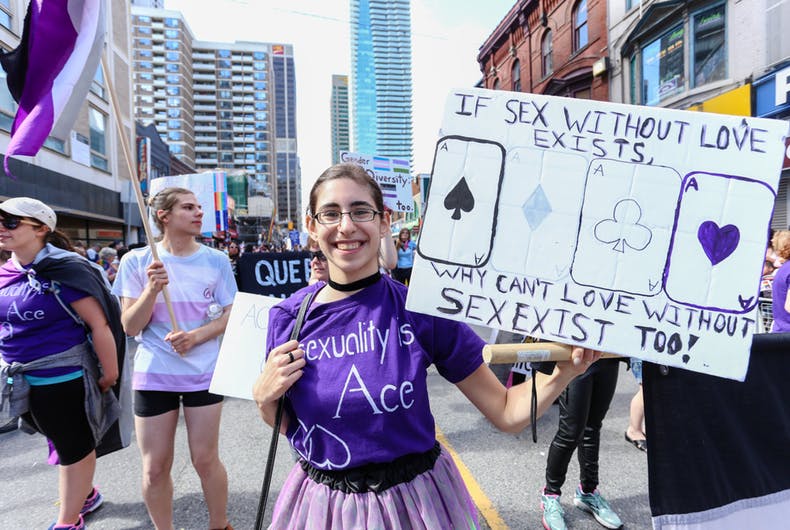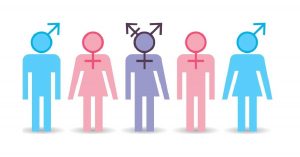Celebrating Ace Awareness Week
Happy Ace Awareness Week! It’s time for some much-needed education about asexuality.
Asexuals march at the Toronto 2017 LGBTQ Pride Parade in Canada.
October 21, 2019
Ace Awareness Week 2019 began yesterday, October 20th, and ends October 26th. This week, we celebrate asexual identities and educate ourselves and the people around us about asexuality and the “ace” spectrum.
What is Asexuality?
Asexuality is a very broad term that is most simply defined as the lack of sexual attraction to others. An extremely low desire to have sex, sex-repulsion and other atypical manners of sexual attraction can also be considered to be under the umbrella of asexuality, or on the asexual spectrum.
Asexual identities are, like most identities, complex due to the ambiguous nature of the term, so there is a spectrum of “ace” identities. This spectrum, commonly referred to as the “ace spectrum,” has grown and continues to grow over time as more individuals with similar nonstandard forms of sexual attraction attempt to describe themselves with more specific terms.
A list of some of the basic identities on the ace spectrum can be found at the end of this article.
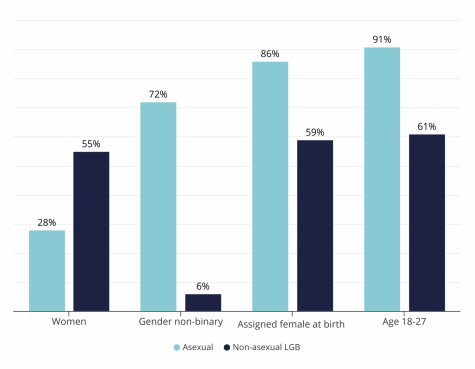
Misconceptions About Asexuality
Not only is it necessary to educate the public about what asexuality is, as is the goal of Ace Awareness Week, but also to correct the many misconceptions associated with asexuality. Some of the most common include the following.
Misconception 1: Asexuality is just a more precise word for celibacy.
Asexuality is a sexual orientation that prevents an individual from experiencing sexual attraction or experiencing it very rarely. One cannot choose to be asexual. Celibacy is a decision, usually due to personal or religious beliefs, of an individual to no longer engage in sex. Asexuality describes a person. Celibacy describes one’s actions. Therefore, the two terms are not interchangeable.
Misconception 2: Asexuals can’t be in relationships and can’t have sex.
Sexual attraction and romantic attraction do not always coincide. There are both asexuals who are alloromantic (experience romantic attraction) and who are aromantic (do not experience romantic attraction).
Many asexuals engage in sexual activities even if they aren’t sexually attracted to their partner for reasons such as wanting to have a child or to please their partner.
Misconception 3: Having sex “fixes” asexuality.
There is no proven method to “fixing” any sexual orientation identity, nor is there a need to. This kind of thinking assumes that asexuals would prefer to have sex and that sex is essential to romantic relationships, neither of which is true.
Heteronormativity is the idea that heterosexuality is the only normal form of sexual expression and describes the generalizations that society makes about all relationships based on heterosexual ones. Because asexuals act outside the confines of heteronormative behaviors and assumptions, such as that sex is an essential component of all romantic relationships, their relationships are deemed abnormal or unnatural by society.
Breaking down these heteronormative assumptions challenges the assumption that any sexuality needs to be “fixed” in the first place, or that asexual relationships would be improved if they involved sex.
Misconception 4: All asexuals are straight.
No asexuals are “straight” in terms of sexual attraction. They can be “straight” in terms of romantic attraction, however. Asexuals who engage in romantic relationships with the opposite sex are heteroromantic asexuals, meaning that they are romantically attracted to people of the opposite sex but do not feel sexually attracted to those people.
There are also homoromantic (romantically attracted to the same gender) and panromantic (romantically attracted to all genders) asexuals.
Misconception 5: Asexuality is a mental disorder.
Although some disorders and neurodivergencies such as PTSD and autism can affect or be related to asexuality, it is not a mental disorder.
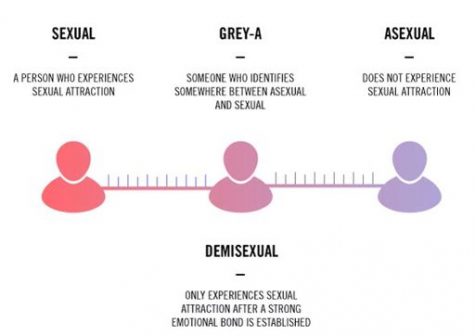
Are Asexuals Included in the “+” of LGBT+?
The inclusion of asexuals into the LGBT+ community has been a long-debated topic, and although the LGBT+ community has at large accepted asexuals, there are many who are still hesitant to further expand the boundaries of the community.
Those against the inclusion of asexuals argue that the LGBT+ community was originally created to bring groups of individuals who have been systematically oppressed due to their sexual orientation or gender identity and their supporting allies together, and that for a group to be included in the community, a history of oppression is required. In other words, asexuals are not a systematically oppressed group, thus they don’t fit into the mold of an LGBT+ identity.
Those for their inclusion argue that even though asexuals are not systematically oppressed, they face many struggles throughout their lives because of their identities, that it is important for the LGBT+ community to promote inclusion across all sexualities and gender identities, and that gatekeeping causes unnecessary divisions within the community.
How Are We Celebrating Ace Awareness Week at Woodford?
Here at Woodford, we’re creating a poster that will stretch across an entire wall of various identities within the LGBT+ community along with their correlating flags and definitions and other information about them; this poster includes the asexual pride flag and information about asexuality and the ace spectrum, as well as information about aromanticism, which is the lack of romantic attraction.
We’re also working to educate students about ace identities by writing articles like this one and informing students about the ace-inclusive Gay-Straight Alliance (GSA) at WCHS.
There are open GSA meetings during HIVE on the first Tuesday of every month.
How Can You Participate?
If you have any ace friends, ask them where on the spectrum they identify. Ask them about their experience and be accepting of it.
By doing so, you may find with the knowledge of where your ace friend lies on the spectrum that they’d prefer that you change the way you interact with them. For example, if they’re sex-repulsed, you’ll want to avoid conversations about sex or sex-related topics.
However, it’s also important to understand that asexuals can still be excited by or want to hear about sex-associated topics, so you shouldn’t immediately exclude them from such conversations.
Simple acts like creating an Instagram/Snapchat story or post acknowledging Ace Awareness Week spark necessary questions and conversations about asexuality.
What Are Some of the Basic Identities on the Ace Spectrum?
Unless asked specifically where on the ace spectrum someone falls, they are most likely to publicly identify as asexual for the sake of simplicity and because many people even in the LGBT+ community refuse to take these more specific identities seriously.
Nonetheless, asexuals appreciate and feel validated by people who are willing to take the initiative to educate themselves about the asexual spectrum and to understand the identities on it.
Asexual

Does not experience sexual attraction
Encompasses all of the identities on the ace spectrum
Aromantic

Does not experience romantic attraction
Demisexual

Does not experience primary sexual attraction
Only experiences sexual attraction after a deep emotional connection is formed
Gray-Ace
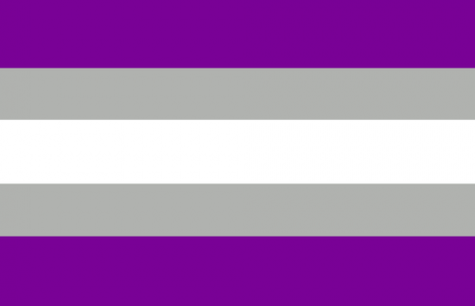
Short for gray-asexual
Represents those who lie on the spectrum between asexuality and sexuality
These are the four most basic ace spectrum identities. There are others such as reciprosexual and akoisexual, but they are for the most part deemed too complex to require their own labels. Therefore, they are grouped in with other gray-ace (listed below) identities.
Visit the Asexual Visibility and Education Network website for more information about asexuality and the ace community.

